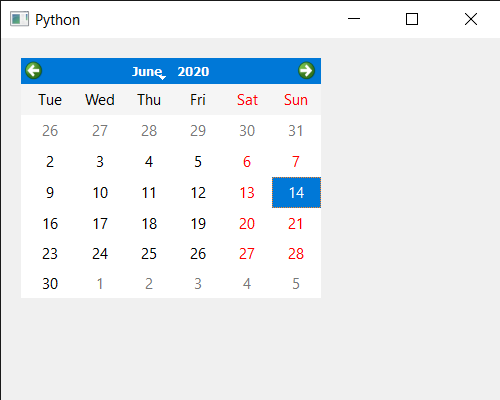En este artículo veremos cómo podemos eliminar, es decir, borrar la máscara del QCalendarWidget. La máscara se usa básicamente para ocultar el calendario, con la ayuda de la máscara, el usuario no podrá ver todo el calendario, aunque el calendario seguirá existiendo, pero habrá una máscara en él. Podemos configurar la máscara en el calendario con la ayuda del setMaskmétodo .
Para hacer esto, usaremos
clearMaskel método con el objeto QCalendarWidget.Sintaxis: calendario.clearMask()
Argumento: no requiere argumento
Retorno: No devuelve Ninguno
A continuación se muestra la implementación.
# importing libraries
from PyQt5.QtWidgets import *
from PyQt5 import QtCore, QtGui
from PyQt5.QtGui import *
from PyQt5.QtCore import *
import sys
# QCalendarWidget Class
class Calendar(QCalendarWidget):
# constructor
def __init__(self, parent = None):
super(Calendar, self).__init__(parent)
self.setMouseTracking(True)
class Window(QMainWindow):
def __init__(self):
super().__init__()
# setting title
self.setWindowTitle("Python ")
# setting geometry
self.setGeometry(100, 100, 500, 400)
# calling method
self.UiComponents()
# showing all the widgets
self.show()
# method for components
def UiComponents(self):
# creating a QCalendarWidget object
# as Calendar class inherits QCalendarWidget
self.calendar = Calendar(self)
# setting cursor
self.calendar.setCursor(Qt.PointingHandCursor)
# setting geometry to the calendar
self.calendar.setGeometry(20, 20, 300, 240)
# QRect object
rect = QRect(10, 10, 200, 100)
# creating a QRegion
region = QRegion(rect)
# setting mask to the calendar
self.calendar.setMask(region)
# clearing the mask
self.calendar.clearMask()
# create pyqt5 app
App = QApplication(sys.argv)
# create the instance of our Window
window = Window()
# start the app
sys.exit(App.exec())
Producción :
Publicación traducida automáticamente
Artículo escrito por rakshitarora y traducido por Barcelona Geeks. The original can be accessed here. Licence: CCBY-SA